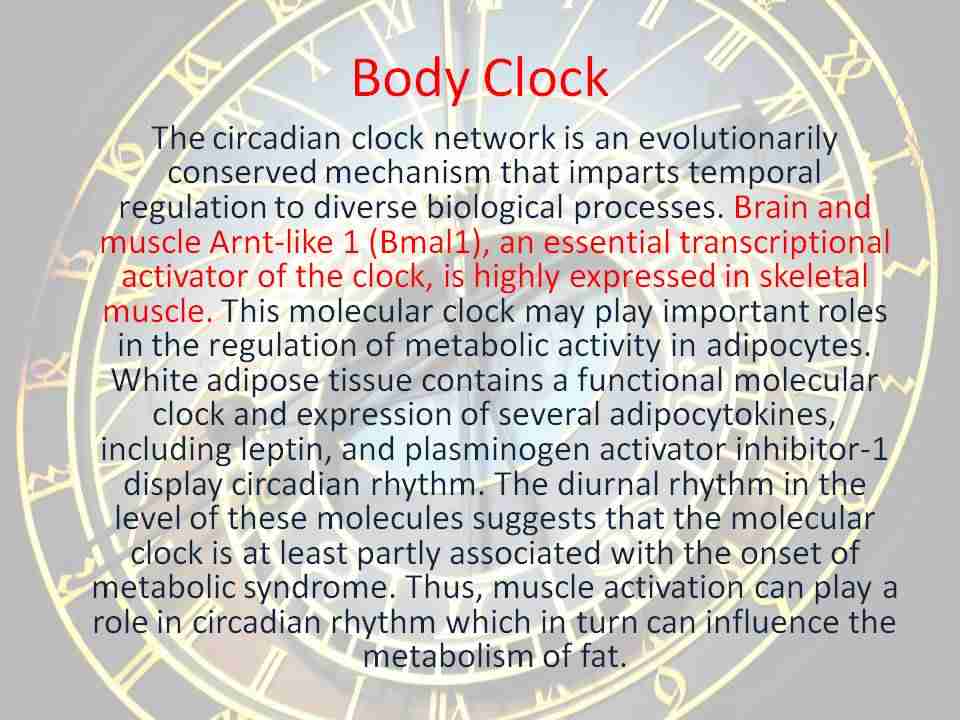Skeletal muscle clock disruption
by Martin Krause (B Appl Sc Physio; Master Appl Sci Manip Physio, Grad Dip Hlth Sc (Ex and Sp), Grad Cert hlth Sc Edu, Cert IV Workplace Assessment and Training
Skeletal muscle contribute to approximately 40% of body mass, Apart from performing work, maintaining posture and providing locomotion, they contribute to systemic physiological and metabolic function, including considerable cross talk with the liver, pancreas, adipose tissue and bone. Disruption of musculoskeletal circadian metabolic function leads to peripheral insulin resistance, glucose intolerance, increased energy expenditure and fasting hypoglycaemia.

A review by Erickson ML et al (2021 Ex Sp Sc Reviews 49, 1, 35-41) discussed the diurnal variation of metabolism and substrate preference. Substrate preference has an evolutionary advantage where high carbohydrate utilisation occurs in the morning. with muscles increasing insulin sensitivity, whilst a high fat storage for later oxidation is preferred in the evening. Skeletal muscle oxidative capacity peaks around 2300 and is lowest at 0400 suggesting mitochondrial dynamics rather than biogenesis being the driving factor. Hence, muscles fine tune the expectations of energy expenditure required to perform work.
Skeletal muscle clock regulates the myotubule secretion of basal myokines, including Interleukin-6 (IL-6), IL-8 and macrophage stimulating factor - 1 (Perrin L et al 2015, Molecular Metabolism, 4, 11, 834-845). Investigations with Clock mutant mice, have demonstrated reduced GLUT-4 mRNA and protein levels, meaning less ability for muscles to absorb glucose. Circadian rhythms from human donors with various phenotypes appear to demonstrate dampened in metabolic disease. Moreover, metabolic genes under control of Clock show robust rhythmic expression when cultured from lean exercised trained donors, which wasn't observed in donors with type II diabetes (Hansen J et aL 2016, Sci Rep, 6, 35047). Since muscle is responsible for 80% of post insulin release glucose absorption, it is conceivable that skeletal muscle Clock disruption, affects glucose excursions which are the hallmark of type II diabetes.
Sleep
One night of restless sleep, sleep loss or wakefulness has a significant impact on increases of BMAL1 protein expression, a core component of molecular Clock leading to downstream upregulation of fatty acid uptake and reduced activation of glycolytic pathways (Cedernaes J et al 2018 Sci Adv 4, 8, eaar8590). Circadian mal-alignment studies, reveal metabolic phenotypes of a pre-diabetic state, including increased glucose despite increased insulin, increased mean arterial blood pressure, reduced sleep efficacy and reduced leptin (Scheer FA et al 2009, Proc Nat Acad Sci, USA, 106, 11, 4453-8). Suggestions are, that the skeletal muscle clock orchestrates "sleeping metabolism" even during states of wakefulness.
Exercise to reset the skeletal muscle clock
In humans, an acute exercise session (both endurance and resistance training), increases skeletal muscle Clock gene expression (Popov DV et al 2018 Biol Sport, 35, 3, 277-89; Zambon AC et al 2003, Genome Biol, 4, 10, R61).Thanks to the paucity of human investigations, it remains to be elucidated whether there is an optimal time to exercise, since carbohydrate metabolic preference seems to be greater in the mornings, this may mean that greater glucose utilization may occur in the morning, resulting in more effective insulin use and/or Glut-4 mediated glucose uptake by skeletal muscle? Yet lipid based metabolism may be more preferred training objective in over weight individuals and hence exercise in the afternoon may be more beneficial? Unfortunately, limited knowledge, on timing of exercise, can be gained from animal studies, as feeding and foraging frequently occur at night. Additionally, the effect of 16:8 fasting diets and morning exercise might also need to be considered. Anecdotally, my clinical observations are that significant weight loss can occur using a morning exercise regime along with 16 hours of fasting.
Exercise and weight loss
A minimum of 300KCal of energy expenditure every 72 hours is required for weight loss.



The greater the calorific expenditure, the greater the weight loss.

Conclusion
It is plausible and conceivable that skeletal muscles are an organ of circadian rhythm, which have an impact on multiple organs associated with energy expenditure. From an evolutionary perspective, gaining of food was associated with work, which generally occurred during the day. Shifts in metabolic preferences and immune preference suggest an important role of the skeletal muscle Clock. Further investigations are required to fully understand the impact of exercise on people who have poor sleep hygiene, work shifts or fly regularly across multiple time zones. Additionally, the impact of 'timing of exercise' still needs to be elucidated, especially when adding calorific restriction variables such as the 16:8 diet.
Uploaded : 10 August 2022




